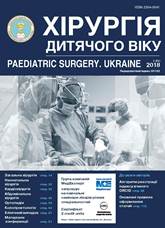Surgical management of simple gastroschisis
DOI:
https://doi.org/10.15574/PS.2018.59.25Keywords:
gastroschisis, simple GS, visceral-abdominal disproportion, abdominal compartment syndrome, surgical managementAbstract
Until now, issues regarding the appropriate way of surgical management of simple gastroschisis (GS) remain unsolved.Objective: to investigate the rate and effectiveness of surgical treatment in the application of various types of surgical interventions as well as postoperative course in patients with simple GS.
Material and methods. A prospective study of 54 newborns with GS that were managed using the «first minute surgery» method during the period from 2006 to 2017 was conducted. To achieve the stated objective, all patients with GS were divided into two groups. Group І included children with simple GS (n=41), newborns with complicated GS were enrolled to the II group (n=13).
Results. According to the results of our study, among 54 newborns with GS, 41 (75.9%) children had simple GS. There were a significantly lower rate of postoperative surgical complications, sepsis, time duration before complete enteral nutrition administration and hospitalization (P<0.05) in newborns with simple GS. During the surgical management of the defect in these children, anterior abdominal wall (AAW) patches were used statistically rarely (p=0.03). The AAW defect repair with local tissues and minimal ventral hernia primary formation leads to a decrease in the incidence of abdominal compartment syndrome.
Conclusions. Simple GS occurs in 75.9% of newborns with this malformation. The AAW defect repair with local tissues and primary formation of the minimal ventral hernia in children with simple GS is the appropriate way of surgical management of defect with absent or moderate viscero-abdominal disproportion (VAD). The combined staged AAW plastic is indicated when severe VAD occurs.
References
Sliepov OK, Hrasiukova NI, Veselskyi VL. (2014). Rezultaty «khirurhii pershykh khvylyn» pry likuvanni hastroshyzysu. Perynatologiya i pediatriya. 4: 18-23. doi10.15574/PP.2014.60.18
Sliepov OK. (2012). Pat. 77788 Ukraina, MPK A61B 17/00. Sposib plastyky pupkovoho kiltsia pry hastroshyzysi u novonarodzhenykh. Zaiavnyk ta vlasnyk patentu DU «IPAH NAMN Ukrainy». No.201210316. Zaiavl. 31.08.2012. Opubl. 25.02.2013, Biul. № 4.
Bousema S, Stas HG, van de Merwe MH, Oen IM, Baartmans MG, van Baar ME. (2016, Sep). Epidemiology and screening of intentional burns in children in a Dutch burn centre.; Dutch Burn Repository group, Maasstad Hospital Rotterdam. Burns. 42(6): 1287-94. https://doi.org/10.1016/j.burns.2016.01.009.
Child Safety and Injury Prevention: Burn Prevention. Centers for Disease Control and Prevention; Atlanta, GA, USA. (2016). https://www.cdc.gov/safechild/burns/index.html.
Elton Mathias, Madhu Srinivas Murthy (2017). Pediatric Thermal Burns and Treatment: A Review of Progress and Future Prospects. Medicines (Basel). 4(4): 91. https://doi.org/10.3390/medicines4040091; https://doi.org/10.20944/preprints201711.0204.v1. https://www.ncbi.nlm.nih.gov/pmc/articles/PMC5750615 /
Michael H Toon, Dirk M Maybauer, Lisa L Arceneaux, John F Fraser, Walter Meyer, Antoinette Runge, Marc O Maybauer. (2011). Children with burn injuries-assessment of trauma, neglect, violence and abuse. J Inj Violence Res. 3(2): 98–110. https://doi.org/10.5249/jivr.v3i2.91.
Stoddard FJ, Ronfeldt H, Kagan J, Drake JE, Snidman N, Murphy JM, Saxe G, Burns J, Sheridan RL. (2006). Am J Psychiatry. Young burned children: the course of acute stress and physiological and behavioral responses. 163(6): 1084-90. Doi 10.1176/ajp.2006.163.6.1084
Vijay Krishnamoorthy, Ramesh Ramaiah, Sanjay M Bhanankerint. (2012). J Crit Illn Inj Sci. Pediatric burn injuries. 2(3): 128–134. https://doi.org/10.4103/2229-5151.100889; PMid:23181206 PMCid:PMC3500004
World Health Organisation. (2017). Burns, fact sheet. A WHO plan for Burn Prevention and Care. http://www.who.int/mediacentre/factsheets/fs365/en.
Downloads
Issue
Section
License
The policy of the Journal “PAEDIATRIC SURGERY. UKRAINE” is compatible with the vast majority of funders' of open access and self-archiving policies. The journal provides immediate open access route being convinced that everyone – not only scientists - can benefit from research results, and publishes articles exclusively under open access distribution, with a Creative Commons Attribution-Noncommercial 4.0 international license(СС BY-NC).
Authors transfer the copyright to the Journal “PAEDIATRIC SURGERY.UKRAINE” when the manuscript is accepted for publication. Authors declare that this manuscript has not been published nor is under simultaneous consideration for publication elsewhere. After publication, the articles become freely available on-line to the public.
Readers have the right to use, distribute, and reproduce articles in any medium, provided the articles and the journal are properly cited.
The use of published materials for commercial purposes is strongly prohibited.

